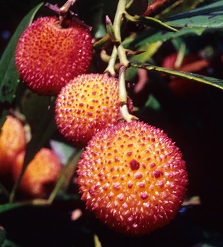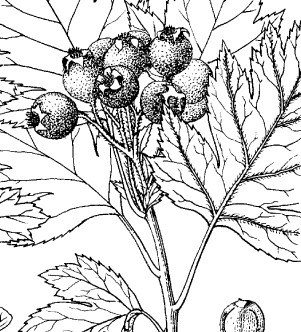
Q:
Hawthorn fruit is valued in traditional Chinese medicine for digestion, circulation, blood pressure, and anything to do with the heart. What types of hawthorn could I grow here in the Pacific Northwest that share the same medicinal properties as the ones used in China? I found some fruit on a tree in my neighborhood that reminds me of the dried hawthorn fruit we used, but someone told me this was a strawberry tree, not a hawthorn.
A: Strawberry tree is the common name for
Arbutus unedo. Its very bumpy fruit (shown in this photo) is edible but not especially tasty (the species name means 'I eat one,' because one would be enough to convince the eater to seek a better food source!). Unlike deciduous hawthorns,
Arbutus is evergreen. I can imagine, if you have only seen medicinal hawthorn fruit in dried form, it would be easy to mistake it for the strawberry tree’s fruit. Chinese hawthorn fruit has a comparatively smooth surface, though it is dotted with lenticels (that allow for exchange of gases between the outside world and the fruit’s interior).

We are not medical professionals, so we cannot address the medicinal benefits of any plant. However, there are several species of
Crataegus (hawthorn) that are native to China, and some of these have fruit considered useful for the medicinal purposes you mention. The species that come up most often are
Crataegus pinnatifida
(shan zha, shown in this drawing) and
Crataegus hupehensis. In the article "Hawthorn (Crataegus) Resources in China" (Taijun Guo and Peijuan Jiao,
HortScience, Vol. 30(6), October 1995), there is a list of all the species that grow in various regions of China. The most useful ones are likely those that have sizeable fruit. There are also quite a few cultivated varieties, especially of
C. pinnatifida
, C. scabrifolia, and
C. hupehensis. There is some history of hawthorn’s medicinal use in Europe as well, but with different species (mainly
Crataegus monogyna— an unregulated noxious weed in King County
— and
Crataegus laevigata, previously called
C. oxyacantha).
If you search online nursery inventory for the Chinese hawthorn species mentioned above, you will see that a cultivar of
Crataegus pinnatifida called 'Red Sun' is available from
Raintree Nursery in Washington, and
One Green World in Oregon. You could certainly try growing it here, provided you have the right space for a 15-foot tree that needs full sun. When the fruits ripen (in the fall here), you could even scoop out the seeds, fill them with red bean paste, skewer them, and dip them in sugar syrup to make
tanghulu, a treat for Chinese New Year.